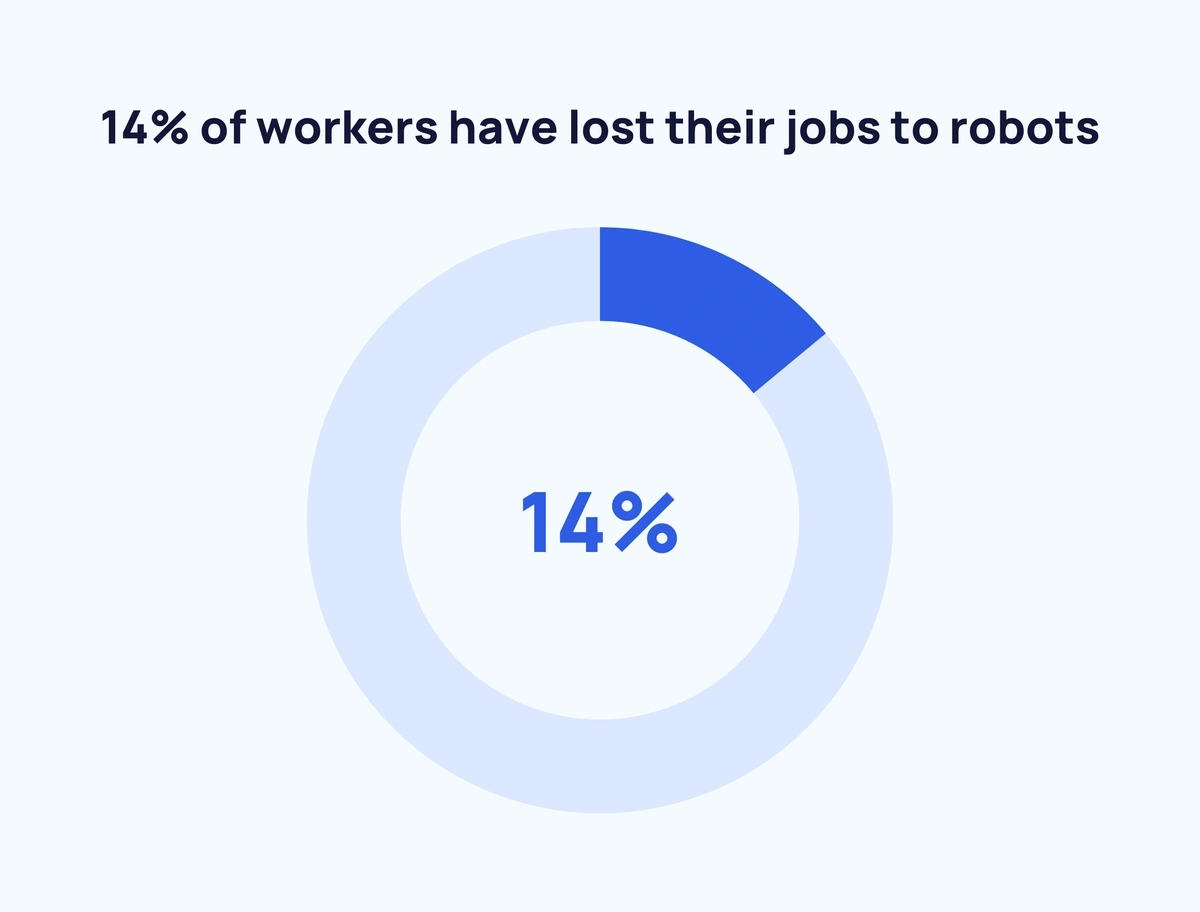Robots Statistics 2024 By Revenue, Usage and Companies

WHAT WE HAVE ON THIS PAGE
Introduction
Robots Statistics: We are all aware of the rapid evolution of advanced technology in this generation. Robots have become an integral part of every global business sector. Millions of robots work every day to make our lives easier. Robots can perform a variety of tasks that can sometimes be challenging for humans. If you are interested in the robot industry, Robots Statistics can provide you with all the current market trends to guide you effectively.
Editor’s Choice
- The global robots market is expected to reach $38.24 billion by 2024 and increase to $43.32 billion by 2027.
- Currently, there are over 3.4 million industrial robots in use worldwide.
- In manufacturing industries around the world, there is 1 robot for every 71 humans.
- Industrial companies are planning to spend about 25% of their capital on robots over the next five years.
- Robots have replaced 14% of jobs globally.
- In 2023, Asia had the highest number of robots, with 263.4 thousand units.
- The market for AI-powered robots is expected to grow to $184.75 billion by 2030.
- 83% of manufacturing industries use robots for tasks like palletizing and packaging.
- The main advantages of using robots include a 95% increase in production speed and a 92% increase in production capacity.
- By 2030, around 90% of businesses plan to use robotics.
Facts About Robots
(Source: ifr.org)
- By 2024, the global robots market is expected to reach $38.24 billion and increase to $43.32 billion by 2027.
- Currently, there are over 3.4 million industrial robots in use worldwide.
- In manufacturing industries around the world, there is 1 robot for every 71 humans.
- Industrial companies are planning to spend about 25% of their capital on robots over the next five years.
- Robots have replaced 14% of jobs globally.
- In 2023, Asia had the highest number of robots, with 263.4 thousand units.
- The market for AI-powered robots is expected to grow to $184.75 billion by 2030.
- 83% of manufacturing industries use robots for tasks like palletizing and packaging.
- The main advantages of using robots include a 95% increase in production speed and a 92% increase in production capacity.
- By 2030, around 90% of businesses plan to use robotics.
Types of Robots
- The most used robots in 202 and 2024 are industrial robots; they can do all the work as humans, from surgeries to building cars and manufacturing parts.
- Traditional industrial robots are being used by 87% of companies worldwide to date.
- 55% of companies use collaborative robots, which can efficiently work without any human contact.
- Other types of robot statistics by company share are followed by automated guided vehicles (74%) and a robotic system by robots and human controllers (63%).
General Robots Statistics
- As of 2024, the global shipments of industrial robots are expected to reach 518,000 units.
- The market valuation of military robotics is estimated to be worth $16.5 billion by 2025.
- Across the global robots sector, approximately 150,000 workers are employed in engineering and assembly.
- CurrentlyCurrently, 88% of organizations have implemented robotic automation into their infrastructure.
- By 2025, more than 50,000 warehouses will install over 4 million commercial warehouse robots.
- The market valuation of warehouse robots is expected to account for $10.86 billion by 2030, with a CAGR of 11.8%.
- According to Strategic Market Research analysis, 2.1 million robots will be shipped by 2025, and 860,000 units will be shipped alone in 2025.
- Each year, roughly 400,000 new robots are invented across the global market.
- There are approximately 132,500 robotics engineers in the United States, and this number is projected to grow by 6.4% from 2016 to 2026.
(Reference: zippia.com)
- According to the above line chart, the robot industry’s market size was $104.6 billion in 2023, and it is estimated to be $117.2 billion by 2024.
- Furthermore, the market size of the robot industry is going to reach higher such as 2025 ($129.1 billion), 2026 ($141.2 billion), 2027 ($153.4 billion), and 2028 ($165.3 billion).
- Revenue growth of the North American robotics industry will be 11.67% of CAGR by 2026.
Industrial Robotics Market Volume Statistics
(Reference: statista.com)
- In 2023, Asia’s highest robotics volume was observed, with 269.4 thousand units. Whereas other regions’ market volume is followed by Europe (79.75K), North America (56.05K), South America and the Caribbean (22.24K), Africa (6.94K), and Australia and Oceania (0.96K).
- As of 2024, worldwide market volumes of industrial robotics are followed by Asia (263.4K), Europe (84.86K), North America (56.79K), South America and the Caribbean (22.81K), Africa (7.93K), and Australia and Oceania (1K).
- Predicted market volume from 2025 to 2028 is followed by Asia (258.5K, 254.4K, 250.7K, and 247.1); Europe (87.78K, 90.5K, 92.38K, and 94.27K); North America (57.6K, 58.31K, 59.07K, and 59.82K); South America and the Caribbean (23.37K, 23.72K, 23.88K, and 24K); Africa (8.71K, 9.15K, 9.52K, and 9.89K); and Australia and Oceania (1.05K, 1.09K, 1.13K, and 1.17K) respectively.
Global Robots Revenue Statistics
- Worldwide revenue earned by the robotic market was almost $37.37 billion in 2023.
- Whereas, in 2024, the robotic service revenue will account for the majority share of industrial revenue, resulting in $38.24 billion
- Meanwhile, the global robotics market is expected to grow gradually over the next few years, according to Statista reports. 2025 ($40.04 billion), 2026 ($41.78 billion), 2027 ($43.32 billion), and 2028 ($45.1 billion) will follow.
Annual Installation of Robots (Reference: ifr.org)
(Reference: ifr.org)
- According to the International Federation of Robotics, industrial robot installation in global industries and factories in 2023 resulted in 553K, along with a growth rate of 7%.
- Furthermore, it is expected that in coming years, the installation rates of industrial robots are going to increase, followed by 2024 (622K), 2025(662K) with a 7% growth rate, and 2026 (718K).
- By the end of 2023, around 73% of deployed robots in Asia were installed in Europe (10%) and the United States (10%).
Installed Robot Statistics by Country
- As of 2023, global robot installations are expected to grow 7% from last year, above 590,000 units, 600,000 units by 2024, and 700,000 units by 2026.
- The top 5 countries, the United States, China, the Republic of Korea, Japan, and Germany, have installed around 79% of robots in 2023.
- The United States of America is supposed to generate the highest market revenue, $7.85 billion, in 2024.
- In China, the market size is expected to reach $6.28 billion by 2024 and $11.8 billion by 2032, with a CAGR of 7.5% from 2023 to 2032.
- Expected robotics revenue earned by other countries in 2024 is followed by the Republic of Korea ($1.64 billion), Japan ($2.53 billion), and Germany ($3.12 billion).
Robots Investment Statistics
- By the coming five years, industrial companies will likely invest around 25% of their capital in robots.
- Approximately 23% of retail manufacturing industries plan to invest more than $500 million in robots and automation.
- On the other hand, 15% of food and beverage manufacturers have also planned to invest at least $500 million in upgrading robotics systems.
Robotics Statistics by Companies
- According to a report by Zippia, the five biggest robotics companies worldwide are Honda Motor, Siemens AG, Sony, Denso Corporation, and Midea Group.
- As of 2023, Honda Motor had the highest revenue and market capitalization in the robots industry, with $142 billion and $42 billion, respectively.
- Other top 4 companies earned revenue and market cap are followed by Siemens ($97 billion and $75 billion), Sony ($79 billion and $78 billion), Denso Corp. ($47 billion and $227 billion), and Midea Group ($39 billion and $52 billion).
- Based on industry type, the total number of robot installations statistics are followed by electronics (137,000), automotive (119,000), metal and machinery (64,000), plastic and chemicals (24,000), and food (15,000).
Robotics Statistics by Trending Industries
- As of March 2023, the automotive industry’s operational robot stock accounted for around 1 million units, and investments are primarily observed in the top car-producing industries.
- China is the largest car producer in the world, but it has a low robot density of 772 units.
- The Republic of Korea (2,867 units), Germany (1500 units), the United States of America (1457 units), and Japan (1422 units) are the other countries with the highest industrial robot density in the automotive industry.
- By the end of 2023, the automotive industry has grown by 3.5% after implementing robots.
- Meanwhile, the robotics market size in the pharmaceutical industry is expected to reach $357.9 million by 2030.
- As of 2023, the medical robot market has reached above $10 billion, and the agricultural robot market is predicted to reach $81 billion by 2028.
- Lastly, the market growth of military robotics is supposed to be across 7% of CAGR from 2021 to 2027.
Robot Statistics by Usage
- As of 2024, robots are primarily used in 83% of manufacturing industries for palletization and packaging.
- 82% of robotic automation is used for ground movements and material handling.
- Other usage shares of robots are followed by goods receiving and storage (80%), material handling and forklifts (77%), and sorting (75%).
- As of 2025, robots will be implemented to manufacture 75% of global vehicles.
- In the 1st quarter of 2023, an order of 9,169 unit robots was placed by United States businesses, resulting in $598 billion.
- Almost 67 countries have implemented more than 7.2 million robotic surgeries in the last ten years in the previous ten years.
Robot Automation Workers’ Statistics

(Source: buttercms.com)
- To date, almost 14% of global workers have lost their jobs after robots were installed in different industries.
- As of 2023, almost 47% of individual jobs have been replaced by automation.
- Meanwhile29% of workers have secured positions in global industries as of now.
- According to a report published by Exploding Topics, 65% of robotics engineers have a four-year bachelor’s degree.
- Other degrees of robotic engineers are associate’s degree (15%) and high school diploma (3%).
- The average annual salary earned by robotic engineers is followed by a bachelor’s degree ($99,309), a master’s degree ($112,368), and a doctorate ($124,995).
- Based on working statistics, 28% of robotic engineers worked in companies with employees between 100 and 500; others are private companies (66%) and public companies (25%).
Advantages and Disadvantages of Robotics
- Companies that have already implemented robots allowed them to save costs up to 20% in 2023 and are expected to hit 22% by the end of 2025.
- By 2025, industrial robots are supposed to displace 85 million human jobs.
- The cost of robots is higher; thus, as 16% of survey respondents in 2024 stated, this is the top challenge many companies cannot implement to date.
Future Statistics of Robot Industries
- The leading robotic user is the automotive sector and is predicted to reach $447.8 million by 2027 with a CAGR of 12.3%.
- In the food industry, approximately 90,000 robots are currently used.
- The market valuation of the Food Robotics by 2027 is estimated to grow around $6.6 billion.
- The expected market worth of the healthcare robotics industry will be $3.29 billion by 2025, with a growth rate of 22.9% and $15.4 billion by 2030.
- Meanwhile, the robotic surgeries market is expected to be $20.98 billion by the end of 2030, with a CAGR of 15.77% from 2020 to 2030.
- The hospital robotics market is estimated to approach $20 billion by 2028 with a CAGR of 14%.
- The industry valuation of wearable exoskeleton robotics will reach $3.2 billion by 2027, with a CAGR of 22%.
- Meanwhile, the nursing robotics market is supposed to be valued at over $1.5 billion and grow at a CAGR of 20% by 2027.
- In the U.S., by 2032, the market size of electronic and industrial robots will reach $5,855.9 million, with a growth rate of 11.8%.
Conclusion
After completing the article on robot statistics, it can be stated that robots have become an integral part of worldwide industries as they can perform dangerous and complex work with more enhanced solutions. The robotic implementation also includes several advantages and disadvantages, but most sectors and companies focus on earning higher production rates and revenue shares. This article has helped you understand different segmental analyses of the global robots market based on recent years and some future predictions.






